1931: Humble Beginnings
1933: The Brick Church
1938: The Ladies Aid Society Begins
1943: The Tenth Anniversary
1946: From Mission to Self-Supporting
1949: The Education Building – First Floor
1961: Revisions Galore
1968: Stained-Glass Windows
1972: 40th Anniversary and Homecoming
1931: Humble Beginnings
“And they devoted themselves to the apostles’ teaching and the fellowship,
to the breaking of bread and the prayers.” Acts 2:42 ESV
In 1931 a group of about 200 Lutherans in and around Irmo, S.C. organized Mount Olive Evangelical Lutheran Church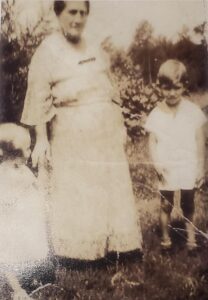 as an independent organization. The members had broken ties with their former churches, St. Andrew’s and St. Michael’s-Lexington, members of the United Lutheran Church in America, because of doctrinal disagreements concerning the inspiration of the Holy Scriptures. Being without a church building, Rev. Fred L. Lineberger and the congregation worshipped for about two months on the lawn of Mrs. Betty Weed’s Irmo home under a large tree. Betty is pictured with her grandchildren, Betty Frances (Hunter) and Henr
as an independent organization. The members had broken ties with their former churches, St. Andrew’s and St. Michael’s-Lexington, members of the United Lutheran Church in America, because of doctrinal disagreements concerning the inspiration of the Holy Scriptures. Being without a church building, Rev. Fred L. Lineberger and the congregation worshipped for about two months on the lawn of Mrs. Betty Weed’s Irmo home under a large tree. Betty is pictured with her grandchildren, Betty Frances (Hunter) and Henr
Pastor Lineberger held afternoon worship services in Lexington at the home of Mrs. Lottie Weed and evening services in an old building in Lexington Mill Village. At that time, Mr. Frank Weed offered the use of his store building in Irmo, located at 1201 Lake Murray Boulevard, across from the current Taco Bell. During this time, the Lineberger family, The Playing Parson’s Band, provided the music.
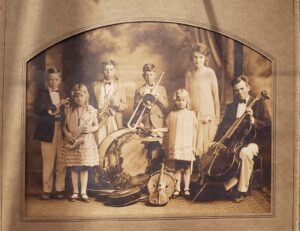 The Rev. Lineberger, pastor, along with Rev. James L. Summers and Rev. Leslie F. Frerking from the LCMS Southeast Area Mission Board, oversaw the process of organizing the church and its acceptance into the Lutheran Church – Missouri Synod in 1932. Soon the process of purchasing land for a church, a parsonage, and a cemetery began. On August 11th, two acres were purchased from Mr. E.H. Hope for $500. (This property is the current site of the church.) The ladies of Mount Olive got right to work with their quilt fundraiser. Individuals who contributed to the building fund had their names embroidered onto the quilt.
The Rev. Lineberger, pastor, along with Rev. James L. Summers and Rev. Leslie F. Frerking from the LCMS Southeast Area Mission Board, oversaw the process of organizing the church and its acceptance into the Lutheran Church – Missouri Synod in 1932. Soon the process of purchasing land for a church, a parsonage, and a cemetery began. On August 11th, two acres were purchased from Mr. E.H. Hope for $500. (This property is the current site of the church.) The ladies of Mount Olive got right to work with their quilt fundraiser. Individuals who contributed to the building fund had their names embroidered onto the quilt.
The Sunday after the land was purchased, members held their last worship service in MrWeed’s store. Then on Monday, members of the congregation began the process of cutting and hauling wood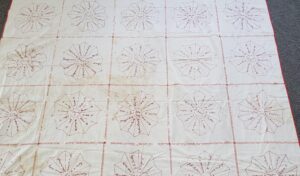 to Mrs. Betty Weed’s family sawmill, and then on to the building site. Other members provided financial support for the purchase of roofing materials and nails. Still other members erected a temporary building, without a floor, that was ready in time for the following Sunday service! Founding member, Mrs. Gladys Meetze remembered coming to church early on Sundays to sweep the dirt and sawdust floor with hand-made brooms as pictured. This broom was found under the subfloor of the sanctuary during the 2000 renovations.
to Mrs. Betty Weed’s family sawmill, and then on to the building site. Other members provided financial support for the purchase of roofing materials and nails. Still other members erected a temporary building, without a floor, that was ready in time for the following Sunday service! Founding member, Mrs. Gladys Meetze remembered coming to church early on Sundays to sweep the dirt and sawdust floor with hand-made brooms as pictured. This broom was found under the subfloor of the sanctuary during the 2000 renovations.
![]() On cold mornings, boys Rufus Meetze and Henry Lawhorne would build a big fire in the pot belly
On cold mornings, boys Rufus Meetze and Henry Lawhorne would build a big fire in the pot belly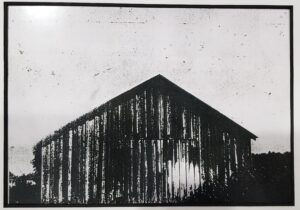 stove that would keep the church warm for the entire worship service.And in the summer, cardboard fans from the local funeral homes were the only means of cooling. This building, pictured below, continued to be used for the 200 members’ worship services until the permanent church building was completed a year later.
stove that would keep the church warm for the entire worship service.And in the summer, cardboard fans from the local funeral homes were the only means of cooling. This building, pictured below, continued to be used for the 200 members’ worship services until the permanent church building was completed a year later.
1933: The Brick Church
“Unless the Lord builds the house, those who build it labor in vain.” Psalm 127:1a ESV
In April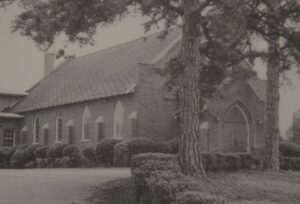 1933, the congregation applied for a $1,500 loan from the General Church Extension Fund of Synod. The loan was later increased to $2,000. With the financial aid, the hiring of two brick masons, countless hours of donated labor and donated materials on the part of the congregation, and the Roof Lumber Company (who used the donated materials to construct the doors, windows, pews, and altar furniture) it was possible on August 27, 1933 to dedicate a “beautiful brick structure of churchly appearance” with a seating capacity of 250. Building the church in the depression years was challenging; however, securing free labor from members of the congregation made it possible to construct a church for only $2,000!
1933, the congregation applied for a $1,500 loan from the General Church Extension Fund of Synod. The loan was later increased to $2,000. With the financial aid, the hiring of two brick masons, countless hours of donated labor and donated materials on the part of the congregation, and the Roof Lumber Company (who used the donated materials to construct the doors, windows, pews, and altar furniture) it was possible on August 27, 1933 to dedicate a “beautiful brick structure of churchly appearance” with a seating capacity of 250. Building the church in the depression years was challenging; however, securing free labor from members of the congregation made it possible to construct a church for only $2,000!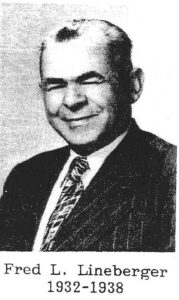 The temporary building, still without a floor, became a place for fellowship and social activities. The years were years of hardship for both pastor and congregation as they received no subsidy from the Mission Board. Even Pastor Lineberger had to find other means to support his family. The Ladies’ Aid group contributed many of the necessary items for worship and even took turns cleaning the church. Few of the members had steady incomes, but everyone gave of their God-given gifts and talents and the building was completed in only six months!
The temporary building, still without a floor, became a place for fellowship and social activities. The years were years of hardship for both pastor and congregation as they received no subsidy from the Mission Board. Even Pastor Lineberger had to find other means to support his family. The Ladies’ Aid group contributed many of the necessary items for worship and even took turns cleaning the church. Few of the members had steady incomes, but everyone gave of their God-given gifts and talents and the building was completed in only six months!
The Rev. Fred L. Lineberger, who was instrumental in founding Mount Olive, served as pastor of the congregation from 1931 until June 1938 when the Mission Board called him to Wilson, N.C. In July 1938, the congregation called the Rev. Robert L. Lail, from Catawba, N.C., as its pastor. It was during this time that the congregation turned its focus 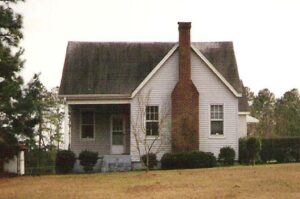 to building a parsonage. In August 1938, the congregation purchased 0.09 of an acre of land for $25. This triangle gave the church 60 more feet along Highway 60 and gave driveway access to the parsonage site. Again, with the hard work of the congregation, in conjunction with an experienced builder, the new parsonage, pictured below, was completed in February 1939 with only a $1000 debt.
to building a parsonage. In August 1938, the congregation purchased 0.09 of an acre of land for $25. This triangle gave the church 60 more feet along Highway 60 and gave driveway access to the parsonage site. Again, with the hard work of the congregation, in conjunction with an experienced builder, the new parsonage, pictured below, was completed in February 1939 with only a $1000 debt.
In December 1939, Pastor Lail accepted a call to Taylorsville, N.C. and the Rev. Gerhardt A. Wagner of Conover, N.C. was called in January 1940 and was ordained and installed in February. In 1944, Pr. Wagner and his high school manual arts class took on the Project of adding a floor to the first building that was being used for the church’s fellowship activities.
1938: The Ladies Aid Society Begins
“Let us lift up our hearts and our hands to God in Heaven!” Lamentations 3:41
A Charter was presented to the Ladies Aid Society of Mt. Olive on April 1938. The purpose was to adopt projects that would help their congregation.
Suppers were held and donations were used for various projects, some of which were the following: Sending layettes to the European Theater of War, honoring the servicemen, contributing to help financially when the church was built in Durham, NC, purchasing candle holders and vases for the altar at Mt. Olive, giving to the Lutheran World Relief, and cleaning the church.
The only record available of the first delegate to a District Convention was September 1947 which was held in Charlotte, NC when Mrs. Walter (Effie) Sons went for one day. Then records show the next mention of delegates was in September 1956 when Yvonne Rodgers and Marge Carter attended in Statesville, NC as delegates. These two have served on the District Board, as well.
During the 1950’s, a night group was formed as many ladies began working. The two groups met until the 1960’s when they merged, meeting at night. During these times, many projects were added including supporting Mission of the Quarter, sponsoring counselors at Camp Linn Haven, supporting District projects (scholarships for students going into full-time church work, early childhood development centers, and contributing to start-up funds for new mission churches).
1943: The Tenth Anniversary
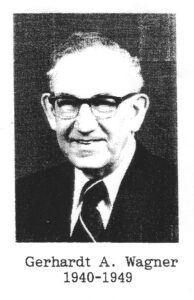 Next came the 10th Anniversary celebration on August 29, 1943. The morning Worship Service was followed by a congregational picnic held outside under the Chinaberry tree. Then at 2:30, Pastor Wagner led a special prayer service for the families and friends of the service men. The Rev. C.O. Smith of Conover, N.C. delivered the anniversary sermon and also gave a history of the Lutheran Church in South Carolina. Fittingly, Rev. Smith was the first LCMS pastor to preach in South Carolina.
Next came the 10th Anniversary celebration on August 29, 1943. The morning Worship Service was followed by a congregational picnic held outside under the Chinaberry tree. Then at 2:30, Pastor Wagner led a special prayer service for the families and friends of the service men. The Rev. C.O. Smith of Conover, N.C. delivered the anniversary sermon and also gave a history of the Lutheran Church in South Carolina. Fittingly, Rev. Smith was the first LCMS pastor to preach in South Carolina.
With the Lord’s help and the leadership of Pastor Wagner, the congregation’s indebtedness was paid off in November 1944. On January 7, 1945, a special thanksgiving service was held to celebrate the Lord’s provision for the paid off mortgage.
1946: From Mission to Self-Supporting
“But seek first the kingdom of God and his righteousness,
and all these things will be added to you.” Matthew 6:33 ESV
Even more importantly, Mount Olive became a self-supporting church beginning in 1946! 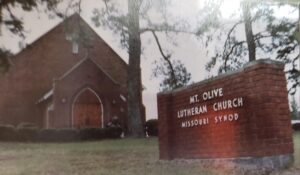 Pastor Herman Scherer of The Mission and Church Extension Board of the Southeastern District LCMS sent a congratulatory letter praising the congregation’s decision and prayed that the Lord would continue to bless Mount Olive.
Pastor Herman Scherer of The Mission and Church Extension Board of the Southeastern District LCMS sent a congratulatory letter praising the congregation’s decision and prayed that the Lord would continue to bless Mount Olive.
Early in 1946, a Hook and Hastings pipe organ was purchased from a Catholic Church in Trenton, New Jersey and installed by Mr. E.A. Johnson of Lynchburg, Virginia. The organ was dedicated on March 3rd with an organ recital given by Mr. Robert Reuter, Dean of Music, Flora MacDonald College in Red Springs, N.C.
1949: The Educational Building – First Floor
“To equip the saints for the work of ministry, for building up the body of Christ.”
Ephesians 4:12 ESV
The year 1946 was full of growth and ministry at Mount Olive, and the decision was made to begin the process for constructing a permanent educational building. It was proposed to build only the first floor of this two-story building at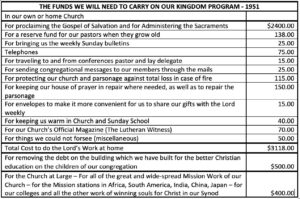 this time. On February 14, 1949, shortly before Pastor Wagner’s departure, the foundation for the educational building was poured and construction began on the first floor. Pastor Wagner preached his farewell sermon February 27, 1949, and the Rev. Roland Haase began his ministry at Mount Olive the same year and
this time. On February 14, 1949, shortly before Pastor Wagner’s departure, the foundation for the educational building was poured and construction began on the first floor. Pastor Wagner preached his farewell sermon February 27, 1949, and the Rev. Roland Haase began his ministry at Mount Olive the same year and 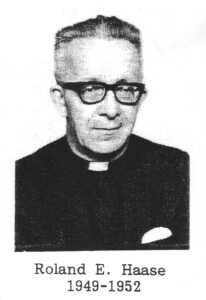 served until June 1952. In 1949, the church parsonage received its first telephone giving easier access to Pr. Haase even when he was not at church. The phone number was only 5 digits, 20610, and cost less than $40 for an entire year.
served until June 1952. In 1949, the church parsonage received its first telephone giving easier access to Pr. Haase even when he was not at church. The phone number was only 5 digits, 20610, and cost less than $40 for an entire year.
Pastor Haase began a church newsletter, Mount Olive Monthly Observer, in 1950. It was printed from the old purple stencils on a mimeograph machine onto thin construction paper. Pictured above is the 1951 proposed budget from the November 1950 Observer.
T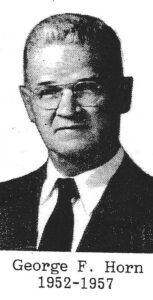 he Rev. George Horn accepted the congregation’s call in November 1952, and served until February 1957, when he accepted a call to Buffalo, New York. During his time at Mount Olive, a new heating system was installed and the inside of the educational building was re-plastered.
he Rev. George Horn accepted the congregation’s call in November 1952, and served until February 1957, when he accepted a call to Buffalo, New York. During his time at Mount Olive, a new heating system was installed and the inside of the educational building was re-plastered.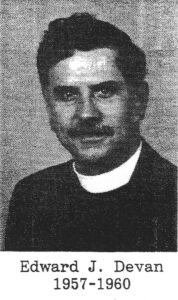
Candidate Edward J. Devan was ordained and installed as pastor on July 14, 1957. The following year, July 30, 1958, the congregation purchased an additional 2.16 acres along Nursery Road from Mr. James Haskell Shealy for $1,031.25. The entire Mt. Olive property purchased in three pieces cost the congregation $1,556.25. According to the 2004 tax records, the land was appraised at $1,062,500.
1961: Renovations Galore
“For no one can lay a foundation other than that which is laid, which is Jesus Christ.”
1 Corinthians 3:11 ESV
The Rev. 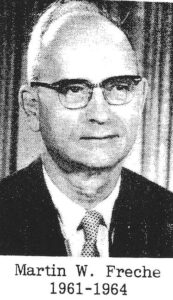 Edward J. Devan served until June 1960 and on October 22, 1961, the Rev. Martin Freche was installed. It was during his ministry that a second floor was added to the educational building because more space was needed for Sunday School. The congregation decided to renovate the inside of the church at the same time. The last Sunday in the old church was on Easter Sunday, April 14, 1963. During this renovation, the church met in the air-conditioned auditorium of Irmo Grade School.
Edward J. Devan served until June 1960 and on October 22, 1961, the Rev. Martin Freche was installed. It was during his ministry that a second floor was added to the educational building because more space was needed for Sunday School. The congregation decided to renovate the inside of the church at the same time. The last Sunday in the old church was on Easter Sunday, April 14, 1963. During this renovation, the church met in the air-conditioned auditorium of Irmo Grade School.
On October 6, 1963, the first worship service was held in the newly renovated, air-conditioned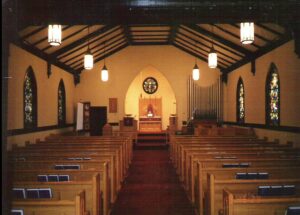 sanctuary. The congregation came together to donate the new pews, altar furnishings, and carpeting. The Service of Rededication was held the afternoon of October 27, 1963 followed by a congregational dinner. Sadly, on June 14, 1964, our beloved Pastor Freche departed this life on the Sunday he was to announce his retirement.
sanctuary. The congregation came together to donate the new pews, altar furnishings, and carpeting. The Service of Rededication was held the afternoon of October 27, 1963 followed by a congregational dinner. Sadly, on June 14, 1964, our beloved Pastor Freche departed this life on the Sunday he was to announce his retirement.
1968: Stained-Glass Windows
“I have filled him with the Spirit of God in wisdom, in understanding, in knowledge,
and in all kinds of craftsmanship.” Exodus 31:3
The 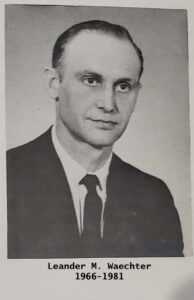 Rev. Leander M. Waechter was installed as pastor of Mount Olive in January 1966. At his installation, Dr. William H. Hahn, President of the Southeastern District, preached and vacancy pastor, Rev. Roland F. Frerking served as the liturgist.
Rev. Leander M. Waechter was installed as pastor of Mount Olive in January 1966. At his installation, Dr. William H. Hahn, President of the Southeastern District, preached and vacancy pastor, Rev. Roland F. Frerking served as the liturgist.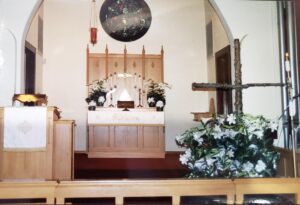
There were several smaller improvements that were made during Pastor Waechter’s time including the installation of the reredos behind the altar, pictured, a project of the Ladies Aid.
During his ministry, there was one major project. Pastor Waechter designed the beautiful 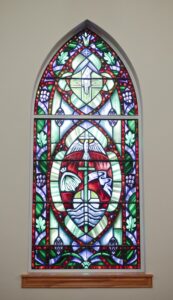 stained-glass windows that currently line the sides of the sanctuary.
stained-glass windows that currently line the sides of the sanctuary.
The ten windows were purchased and installed in 1968. They portray the life of Christ (The Incarnation, The Baptism of Christ, the Redemption, the Resurrection, the Ascension) and the Church Age (Pentecost, the Triumph of the Gospel, Victory, The Word; and the circular Rose window over the altar, now the choir loft, that depicts The Lord’s Supper.)
1972: 40th Anniversary and Homecoming
Mount Olive held a special afternoon of celebration for its 40th anniversary. Mr. Heyward Monts, the master of ceremonies, welcomed the congregation, former members and pastors, and community leaders to the Saturday afternoon picnic, program, special music, ending with an old-fashioned hymn sing. Pastor Waechter was joined by Rev. Gerhart A. Wagner and Rev. George F. Horn, two of the former pastors. Charter member, James H. Shealy, Sr. prepared a “Condensed History of Mt. Olive” that was presented during the festivities. The culmination of the celebration was the Sunday worship service.
